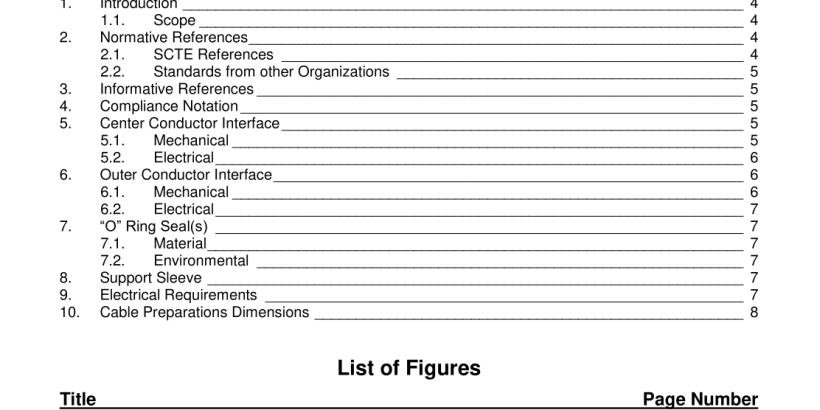ANSI SCTE 156-2019 pdf download.Specification for Mainline Plug (Male) to Cable Interface
1.1. Scope
The primary purpose of this specification is to assure acceptable electrical, mechanical and environmental performance of the cable and connector interface. The scope of this standard will be directed to acceptable performance of impedance, galvanic action, loop resistance, cable retention, intermodulation distortion, signal response, RF shielding, and watertight seals. This specification in no way should limit or restrict any manufacturers from innovative designs and product improvements.
1. This specification applies to the interface between ANSI/SCTE 92, Specification for 5/8 – 24 Plug (Male), Trunk and Distribution Connectors and 75-ohm coaxial aluminum hardline cable manufactured to ANSI/SCTE 15 and ANSI/SCTE 100.
2. 75-ohm coaxial cables and connectors are used to transport radio frequency (RF) signals and AC power between active and passive equipment.
3. Unless otherwise specified, all requirements in this document shall meet the performance requirements stated herein after thermal conditioning from -40 °C to 60 °C.
4. This document includes requirements for DOCSIS 3.1 operation.
2. Normative References
The following documents contain provisions, which, through reference in this text, constitute provisions of the standard. At the time of Subcommittee approval, the editions indicated were valid. All standards are subject to revision; and while parties to any agreement based on this standard are encouraged to investigate the possibility of applying the most recent editions of the documents listed below, they are reminded that newer editions of those documents may not be compatible with the referenced version.
3. Informative References
The following documents may provide valuable information to the reader but are not required when complying with this standard.
• No references are applicable
4. Compliance Notation
This word or the adjective “required” means that the item is an absolute requirement of this specification. This phrase means that the item is an absolute prohibition of this specification. This word means the value specified shall never be used. This word or the adjective“recommended’ means that there may exist valid reasons in particular circumstances to ignore this item, but the full implications should be understood and the case carefully weighted before choosing a different course. This phrase means that there may exist valid reasons in particular circumstances when the listed behavior is acceptable or even useful, but the full implications should be understood and the case carefully weighed before implementing any behavior described with this label. This word or the adjective“optional’ means that this item is truly optional. One vendor may choose to include the item because a particular marketplace requires it or because it enhances the product, for example; another vendor may omit the same item. Use is permissible for legacy purposes only. Deprecated features may be removed from future versions of the standard. Implementations should avoid use of deprecated features.
5.1. Mechanical
The center conductor seizure device shall hold the following cable center conductor sizes to no less than the following retention forces when measured per ANSI/SCTE 102 Cable Retention Force Testing of Trunk and Distribution Connectors, and prepared to the lengths as shown in Figure 2.
5.2. Electrical
The initial contact resistance reading shall not exceed 3 milliohms and may not exceed an additional 2 milliohms after being cycled from -40 °C to 60 °C, with 2 hour dwell times at each temperature extreme and 1 hour ramp times between temperature transitions, for a period of 7 days, as shown in Figure 1 and tested in accordance to ANSI/SCTE 152 Test Procedure for Contact Resistance Measurement of Mainline Plug Interface.
8. Support Sleeve
All connector designs shall incorporate a cable outer conductor support sleeve to ensure meeting all sections of this document. Removing the dielectric of the cable using industry standard tools, as shown in Figure 2, provides the outer conductor support lengths and inside cable diameters.ANSI SCTE 156-2019 pdf download
